This article was written with the assistance of George Heuston, a retired FBI agent with 22 years in the Federal Bureau of Investigation

There were two incidents that were primarily responsible for strengthening the SWAT Team within the modern police force. Those events occurred in 1969 and 1974 respectively and commonly dealt with a menacing barricade stand-off. Soon after, “S.W.A.T”, a network television series came up and cemented the idea of the SWAT Team into the minds of American viewers. Owing to its importance and demand, today there are roughly 1,200 SWAT Teams throughout the United States.
What is SWAT
SWAT stands for Special Weapons and Tactics. The SWAT unit tackles situations that are exceptional and demand the use of specialized tactics and weaponry. The officers who form the SWAT Team go through special training in addition to the FBI Special Agent training. They are authorized to make use of advanced weaponry, armor and surveillance equipment that go beyond the standards of regular police gear.
The earliest members of the SWAT Team at the FBI were special agents. They members represented what was needed on the team for different types of operations. They also had breachers, snipers and sniper observers, EMT paramedics, helicopter operation specialists, and repelling specialists. Heuston was primarily a long gun operator with shoulder weapons on the team.
Members who were formerly Navy SEALs had already been trained and only needed training in the FBI’s way of operating. These agents in turn became the trainers of the evolving SWAT teams. Beyond that, the street agents could also apply and qualify if they passed the physical qualifications, physical tests and had sufficient street time. A typical SWAT agent carried a regular investigative workload like the rest of their colleagues. (See: How to become an FBI agent)
Hostage Rescue Team
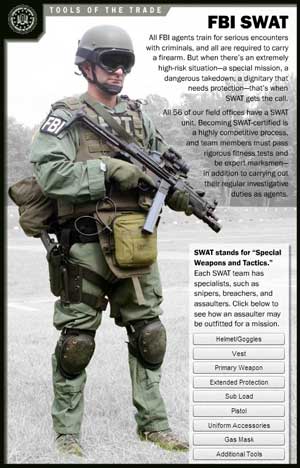
The HRT can basically be considered a SWAT team on steroids. The unit was meant to be deployed more in a military-style operation. SWAT team, on the other hand, included paramilitary law enforcement on the regional teams. (See: Police Hostage Negotiations)
Even during the initial days of their formation, the HRT comprised of all agents. They all had street experience, but their operations were mainly in extreme situations that included executing helicopter operations and rescue missions, carrying out mobile assaults, executing high-risk raids and arrests, providing protection for personnel overseas, and working on manhunts. On the other hand, SWAT teams performed mainly inside their own regions. However, sometimes the FBI SWAT teams from different divisions would be combined to carry out a specific task.
When is SWAT used
The SWAT team is called in for important high-risk situations that include:
- A barricade situation – This is the situation where suspects barricade themselves in a building or any structure that provides them cover and ads complexity for a law enforcement response.
- A high-risk warrant – This is when the team is required to conduct an arrest at home, where the criminal is likely to be armed and dangerous.
- A hostage situation – This is a situation where the suspects are holding hostages.
- Protecting a high-risk person – This is when there are known or believed threats against a high-profile individual or event.
- A terrorist attack – Any situation involves a group or individual is using violence to make a political or ideological statement. (See: FBI Agent Fighting Terrorism)
SWAT Training
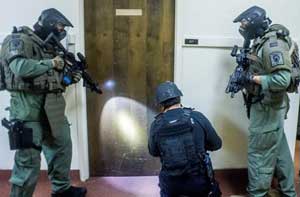
As per Heuston’s experience, in the tactical training sessions, the officers would be given a mission. For the mission, they were briefed about the main objective, where and how things were going to be. However, while on the mission, the officers found out that nothing was ever like what they had planned. This brought home the idea that the plan was basically not going to survive even the first five minutes. They just had to learn to play off each other and work dynamically together. The training days brought the team together and they perfected communicated with team members by non-verbal means. They could either use hand signals or they just knew by a nod. These mutual gestures became a mode of communication when it came to identifying where they were going to go next, and what was going to happen.
Although the training required a good amount of physical challenges, the SWAT Team was never looking for someone who just had a bodybuilder physique. They wanted people who had run their own cases and could think for themselves. Being on SWAT team wasn’t just about the physical aspects. Judgment, tactic and experience were equally important. It was about striking the right balance between using sound judgment as to when and when not to enter into a situation.
SWAT Experiences
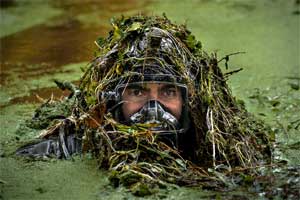
- A few of their urban-type close quarters operations included multiple arrests situations. One of the cases involved a drug arrest. Although the drug cases are usually handled by the the Drug Enforcement Administration (DEA), the FBI SWAT team happened was called upon for a drug case that were located in an Oakland home. Since the subjects were on drugs, they didn’t particularly feel any pain. As the situation unfolded, one of their team members was thrown out of a window twice before the team could finally subdue their suspects.
- There was a combined law enforcement effort in a bank robbery case which soon turned into a chase. It started with the robbers trying to take over a bank. The team had the situation scoped out. However, the robber got away. The situation then turned into a long car chase from San Jose to Palo Alto. En-route, the robber was able to gain some distance because he had a motorcycle and he could also weave in and out of place. The team had a plane up and the California Highway Patrol (CHP) helicopter was utilized. However, the robber, in the process of running away from the team, stopped and robbed a liquor store. But finally, they located him with a K9. The dog found him buried under some leaves in a hedge.
- The team also had to handle a rap group that was conducting robberies in the East Bay. This situation also turned into a chase. However, due to a glitch in the operations, one of the CHP troopers had not been clued in on what was happening. This lead to the breaking of surveillance during the chase. They ultimately ended up going from house to house in search of the robbers who had gotten away on that occasion.
- One of their witness protection cases included the Sonny Barger case. He was the founder of the Oakland chapter of Hell’s Angels. Barger was being federally prosecuted. SWAT teams were required to sit on the high-risk witnesses to make sure they got into trial and testified without incident.
- The team carried out helicopter and ship operations as well. Their ship operation turned into a rural arrest and resulted in seizing half a ton of hashish. Their operation was long term and involved an undercover SWAT agent on it. They had cornered and blocked the suspects. Heuston recounts how he could see one of suspects trying to make a decision as to whether he could push his way through the barricade with a vehicle and get away. Heuston was prepared to shoot if the suspect continued with this vehicle attach, however the suspect realized his situation and decided to stop.
How to Prepare for getting into SWAT
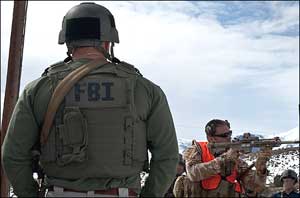
It’s important to be in great shape. The FBI and many other organizations, especially the larger police agencies around the country tend to pull only the seasoned people off the street for SWAT. (See: Police Physical Test Requirements) They won’t usually take a SWAT team member who has just been on the job for six months or a year. Who they want is someone with good police officer experience and judgment.
An aspiring SWAT agent might want to identify the SWAT team leaders. Heuston suggests, “Whoever is running the program, tell them upfront that, I’m not trying to be a blue flame. I’m not trying to light the world on fire or be a Rambo. This has been one of my life goals, I want to be on the team, I want to be on a SWAT team. And this is why I’m in police work. So, if you can assist me in meeting those objectives and maybe mentor me toward that, I’d really appreciate that.” Stating it upfront, willing to wait, and just asking for instructions on what’s the best way for you to approach situations with your agency are a few qualities that will help you identify with them. They can even invite you to come along on a raid by giving you maybe an outer perimeter type situation.
Another great misconception is how the members of the SWAT teams are the people who are bodybuilders like in the movies. But the fact is, a lot of them are rather diminutive and wiry. In fact, the people who are quick and smaller have an advantage of thinking on their feet. A majority of people think that the SWAT teams are just macho. Sure, there is some of that. However, most of it simply involves decent police work and being a decent cop.
How to Get into the FBI

The minimum age of 23 years is required to get into the FBI. However, they usually prefer new recruits that are in their late twenties or early thirties. It’s also important to get grounded in some sort of a long term or extended employment.
The best degrees that qualify you for the job include law, accounting, CPA, MBA, languages, and computer science. When it comes to criminal justice, those degrees are common and may not differentiate someone. Having a computer science degree is very big in today’s scenario. This is because today, almost every crime committed has its soul resting somewhere in a criminal’s cell phone or computer. This is the reason why the subject has become absolutely necessary. Sure, they will train you at your Academy. But having a healthy background in computer science is a massive bonus. (See: Law Enforcement Degree Jobs)
How to get into law enforcement
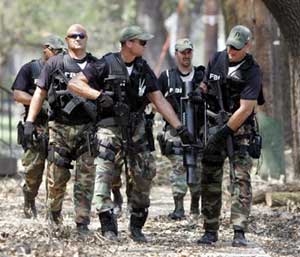
He suggests people aspiring to get into law enforcement look into joining an agencies reserve program. Many police departments and sheriff office have reserves. This helps people establish a successful track record as a reserve officer. It also helps people questions like – Are you trustworthy? Do you show up? Do you do your time with it? Are you effective? These are the qualities that are paramount to get into law enforcement because these are the things that the authorities don’t know about the people who simply walk in from off the street and apply. But if you have a track record with being in a reserve program, it can be extremely beneficial. Reserve programs have similar police hiring and the police officer requirements will be similar for a reserve position as they would be for any peace officer position. There will be a police interview, a police background check, possibly police oral board questions and police polygraph questions. In some agency reserve programs the reserves are many, in some they are not. In a reserve program, the law enforcement authority of the officer is limited to when they are on duty.
Working in a reserve program is one of the police department jobs that is a great way to get your foot in the door, not only with that agency, but with other law enforcement jobs.
How George got into the FBI

He was in law school and the Dean of his law school was a retired Marine Colonel who always liked students who were veterans. George had been over to Vietnam, just like his Dean. So the Dean said, “Heuston, you’re not doing very well. You’re in the bottom third of your class, it’s not looking good for you.” To which George said, “Well, I’m not sure if I really want to do this.”
The dean then asked him, “Well, why are you here?” and George said, “Well, my dad wants me to go into practice with him in a small town. I’ve been away from my dad in the small town for all these years now. And I don’t want to have to be asking for the key to the restroom.”
That is when the Dean asked George if he had ever thought about the FBI. When George said he hadn’t, the Dean remarked, “Well, give it some thought. If you got out and practiced, you’d hit 40, 45 years old and you’d say, what am I sitting around here writing wills for little old ladies for?”
The Dean continued, “With your age now, you can give the FBI a try. If you don’t like it, you can get out and write wills for little old ladies. But at least you will have known and have had that experience.” And the rest, as we know it, is history. (See: Life as an FBI agent)
This article was written with the assistance of George Heuston. He had been in the FBI for 22 years and on the SWAT team #1 in San Francisco for four years. He is the author of three books. His first book is a work of literary non-fiction in which he recounts his experiences as a mountain guide on Mount Rainier during the 60’s. Heuston’s next two books are considered to be the beginning of a series that include his FBI experiences, investigative experiences, spying trails, and an entire line of other fundamental experiences that he achieved during the span of his career. A majority of his SWAT activities in the books are documented from real-life scenarios taken from the people who had been a part of them.
Related Links:
• Police Internships
• Police Officer Jobs
• Getting Hired as a Police Officer
• Detective Jobs

 Joseph Libowsky,
Joseph Libowsky,